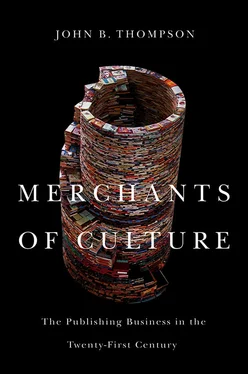As with other fields of activity, the publishing field is an intensely competitive domain characterized by a high degree of inter-organizational rivalry. Firms draw on their accumulated resources in an attempt to give themselves a competitive advantage over their rivals – to sign up bestselling authors and books, to gain the most media attention, etc. The staff of every publishing house are constantly looking over their shoulders to see what their competitors are doing. They constantly scrutinize the bestseller lists and study their competitors’ more successful books to see whether they can pick up clues about how they might develop their own publishing programmes. This kind of inter-organizational rivalry tends to produce a degree of homogeneity or ‘me-too’ publishing among the firms who publish in the same areas – one successful chick-lit book will spawn a dozen look-alikes. But it also produces an intense desire to find the next big thing, as firms are constantly seeking to prevail over their competitors by being the first to spot a new trend.
While many fields of activity are intensely competitive, the publishing field has a competitive structure that is distinctive in some respects. In terms of their competitive position, most publishers are janus-faced organizations: they must compete both in the market for content and in the market for customers . They must compete in the market for content because most publishing organizations do not create or own their own content. They must acquire content by entering into contractual relations with authors or their agents, and this puts them in a competitive position vis-à-vis other publishers who may wish to acquire the same or similar content. A huge amount of effort is invested by editors and publishers in cultivating relations with the agents and others who control access to content. But just as publishers have to compete for content, so too they have to compete for the time, attention and money of retailers and customers once a book has been produced. The marketplace of books is enormously crowded – and becomes ever more crowded as the number of titles published increases every year. Marketing and sales staff devote a great deal of time and effort trying to ensure that their titles stand out from others and are not simply lost in the flood of new books appearing every season. The financial resources of the firm, the social skills and networks of their staff and the accumulated symbolic capital of the imprint and the author are all important factors in shaping the extent to which they can achieve visibility for their titles in the highly competitive and increasingly crowded marketplace for books.
I’ve given three reasons why the notion of field is helpful for understanding the world of publishing but there is a fourth – in my view, the most important. I’m going to argue that each field of publishing has a distinctive dynamic – what I call ‘the logic of the field’. The logic of a publishing field is a set of factors that determine the conditions under which individual agents and organizations can participate in the field – that is, the conditions under which they can play the game (and play it successfully). Individuals who are active in the field have some degree of practical knowledge of this logic: they know how to play the game, and they may have views about how the rules of the game are changing. They may not be able to explain the logic of the field in a neat and concise way, they cannot give you a simple formula that sums it all up, but they can tell you in great detail what it was like when they first entered the field, what it’s like now and how it has changed over time. To use a different metaphor, the logic of the field is like the grammar of a language: individuals know how to speak correctly, and in this sense they have a practical knowledge of the rules of grammar, but they may not be able to formulate these rules in an explicit fashion – they can’t tell you, for example, what the rule is for the use of the subjunctive in English. As Wittgenstein would say, their knowledge of the language is that they know how to use it, they know how to go on. And part of my job as an analyst of the world of publishing is to listen to and reflect on the practical accounts of the agents who are active in the field, to situate these accounts in relation to the agents’ positions in the field and to seek thereby to work out the logic of the field – that is, to formulate it in a way that is more explicit and systematic than one is likely to find in the practical accounts of the agents themselves.
My focus here is on the field of English-language trade publishing – that is, the sector of the publishing industry that is concerned with publishing books, both fiction and non-fiction, that are intended for general readers and sold primarily through bookstores and other retail outlets. I won’t be looking at other fields of publishing – at academic or professional publishing, for example; these fields are organized in very different ways and we cannot assume that the factors that shape the activities of trade publishers will be the same as those that shape the activities of publishers in other fields. 4 My focus is also restricted to the English language, and in practice this means the United States and Britain, 5 simply because publishing fields, like all cultural fields, have linguistic and spatial boundaries and we cannot assume that the dynamics of trade publishing in the English language will be the same as they are in Spanish, French, German, Chinese, Korean or any other language – indeed, the dynamics of trade publishing in other languages are quite different in certain respects. There are even important differences between the United States and Britain, and yet there is also a deep structural similarity in the way that trade publishing works in Britain and the United States, so much so that it makes good sense to see British and American trade publishers as belonging to the same Anglo-American field.
The fact that the Anglo-American publishing industry is the dominant industry in the international arena of trade publishing today is not accidental: it is rooted in a long historical process, stretching back to the nineteenth century and before, which established the English language as the de facto global language and gave Anglo-American publishers an enormous competitive advantage vis-à-vis their counterparts in other languages, who found themselves operating in much smaller and more restricted fields. 6 Today the United States and Britain publish many more new books than other countries and their book exports, measured in terms of volume of sales, are much higher. 7 Moreover, books and authors originally published in English tend to dominate the translation market. Translations from English often feature prominently on the bestseller lists in Europe, Latin America and elsewhere, whereas translations from other languages seldom appear on the bestseller lists in Britain and the US. In the international marketplace of books, the flow of translations and bestsellers is skewed heavily in favour of books and authors originating in the English-speaking world. 8
So does the field of Anglo-American trade publishing have a logic, and if so what is it? That is the question to which this book seeks to provide an answer. Some may doubt whether the world of trade publishing has a logic at all – what we have, they will say, is a complex sphere of activity in which many different agents and organizations are doing many different things, and any attempt to reduce this complexity to an underlying logic of the field is bound to be misleading. Well, let us see; maybe they are right, maybe they are wrong. The social world is a messy place but it is not completely without order, and the task I have set myself is to see if we can discern some order in the plethora of details that make up the diverse practices of everyday life. Of course, I shall not seek to recount all the details – nothing would be more tedious for the reader – nor shall I claim to be able to account for everything that happens in the field. There will always be exceptional events, exceptional actors and exceptional circumstances, but the exceptions should not blind us to the rules. Some actors and some details will feature more prominently in our story than others, and for this I make no apologies. Finding order is about prioritizing detail, attributing more significance to some actors and events than to others, precisely because they tell us more than others do about the underlying structure and dynamics of the field. 9
Читать дальше












